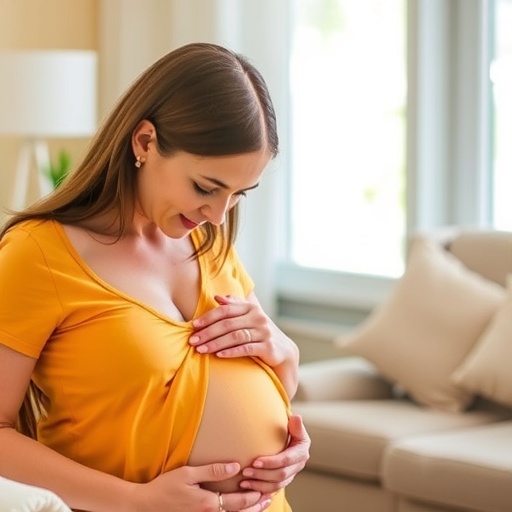A recent study conducted by a dedicated research team at Uppsala University has unveiled a significant association between osteomalacia — a condition characterized by softening of the bones predominantly due to vitamin D deficiency — and a marked increase in the likelihood of emergency obstetric interventions during childbirth. Specifically, this research highlighted a fivefold elevated risk of emergency caesarean sections or vacuum-assisted deliveries among pregnant women diagnosed with osteomalacia. The findings underscore an urgent need to reconsider how maternal health complications linked to bone metabolism disorders are managed and prevented, especially in populations vulnerable to nutritional deficiencies.
Osteomalacia results from defective bone mineralization typically caused by inadequate levels of vitamin D, calcium, or phosphate. In this condition, the bone matrix fails to calcify properly, leading to softened, weakened bones prone to deformities and fractures. While osteomalacia’s skeletal symptoms have been studied for decades, this is among the first investigations to explicitly connect it with critical perinatal outcomes, thereby opening new avenues for understanding the physiological intricacies of labor and delivery.
The Swedish cohort study gathered comprehensive data from two groups of pregnant women residing in Borlänge, Sweden. The participants included 52 Somali women, a demographic known to be at high risk of vitamin D deficiency due to reduced sunlight exposure and other socio-cultural factors, alongside 71 Swedish women who are generally considered to have higher baseline vitamin D levels. Data collection took place on two occasions: during pregnancy, with clinical examinations, questionnaires, and blood sampling, and then follow-up registry data two years later, enabling an assessment of birth outcomes related to their biochemical and clinical status.
The scientific rigor of this research is evident in its innovative utilization of non-invasive, radiation-free diagnostic protocols to identify osteomalacia. This approach circumvents the risks associated with traditional bone biopsy or radiographic procedures, making it feasible to apply in pregnant populations where fetal safety is paramount. The diagnosis hinged on biochemical markers of bone metabolism along with clinical assessments, creating a robust framework for detecting subclinical or overt bone softening.
Analytical methodologies included multinomial logistic regression models adjusted for confounding variables, ensuring the reliability of the observed association between osteomalacia and obstetric interventions. An intriguing aspect of the methodology was the use of Directed Acyclic Graphs (DAGs) for causal inference, allowing researchers to disentangle direct effects of osteomalacia from other intertwined maternal health factors. This represents a sophisticated statistical approach increasingly recognized for its ability to anchor epidemiological findings in causality rather than correlation alone.
Key results revealed that 20 participants, predominantly Somali women with only one Swedish woman affected, met the diagnostic criteria for osteomalacia. Within this subgroup, the incidence of vacuum-assisted deliveries and emergency caesarean sections was significantly elevated compared to their non-osteomalacic counterparts. Such interventions are typically reserved for complications during labor, such as fetal distress or prolonged delivery times, highlighting that osteomalacia may adversely affect the biomechanical or muscular processes critical for normal parturition.
The physiological basis for this elevated risk likely resides in the hallmark symptom of osteomalacia—muscle weakness. Calcium is essential for normal muscle contraction, and its deficiency in osteomalacia can compromise the mother’s ability to generate effective uterine contractions during labor. Additionally, subtle pelvic skeletal deformities caused by compromised bone mineralization could alter the birth canal dynamics, rendering vaginal delivery more challenging and increasing the need for assisted delivery techniques.
Given that vitamin D deficiency is a modifiable and preventable contributor to osteomalacia, these findings have profound implications for public health and antenatal care protocols. Effective supplementation strategies, dietary interventions, and encouraging safe sunlight exposure during pregnancy hold promise for mitigating this risk. Early identification of osteomalacia through biochemical screening could allow timely interventions that not only improve bone health but also reduce the incidence of emergency obstetric procedures.
This study amplifies the call for integrated maternal healthcare approaches that incorporate nutritional assessments alongside traditional obstetric monitoring. In particular, populations with known high prevalence of vitamin D deficiency, such as immigrant communities residing in higher latitudes, must be prioritized for targeted investigations and clinical management to avert preventable childbirth complications.
Moreover, this research invites further inquiry into the mechanistic pathways through which bone metabolism disorders influence labor physiology. Understanding how osteomalacia alters neuromuscular coordination or pelvic biomechanics could inform surgical decision-making and labor management protocols, potentially improving maternal and neonatal outcomes globally.
The translational potential of these findings emphasizes that osteomalacia is not merely a skeletal disorder but one with critical relevance to reproductive health. By spotlighting this connection, the study advocates for a multidisciplinary approach bridging endocrinology, obstetrics, and public health aimed at safeguarding the well-being of mothers and their newborns.
In conclusion, Uppsala University’s groundbreaking prospective cohort study underscores the urgent necessity to recognize and address osteomalacia during pregnancy. Its clear linkage to an increased risk of emergency cesarean sections and vacuum-assisted births demands heightened clinical awareness, preventive strategies centered on vitamin D sufficiency, and further research to optimize maternal-fetal health outcomes in diverse populations.
Subject of Research: People
Article Title: Biochemical osteomalacia reaffirmed by signs and symptoms and perinatal outcome. A prospective cohort study of women in Sweden
News Publication Date: 13-Oct-2025
Web References:
DOI: 10.1016/j.bone.2025.117679
Image Credits: Region Dalarna
Keywords: Osteomalacia, Vitamin D deficiency, Emergency caesarean section, Vacuum-assisted delivery, Pregnancy complications, Bone softening, Maternal health, Perinatal outcomes, Muscle weakness, Directed Acyclic Graphs, Prospective cohort study
Tags: calcium deficiency and maternal healthemergency caesarean sections and vitamin D levelsemergency obstetric interventions in childbirthmaternal health and bone metabolism disordersnutritional deficiencies in pregnant womenosteomalacia and childbirth outcomesperinatal outcomes and osteomalaciapregnancy complications and vitamin D deficiencySomali women and pregnancy risksunderstanding labor complications related to bone healthUppsala University research on vitamin Dvitamin D deficiency and pregnancy complications





